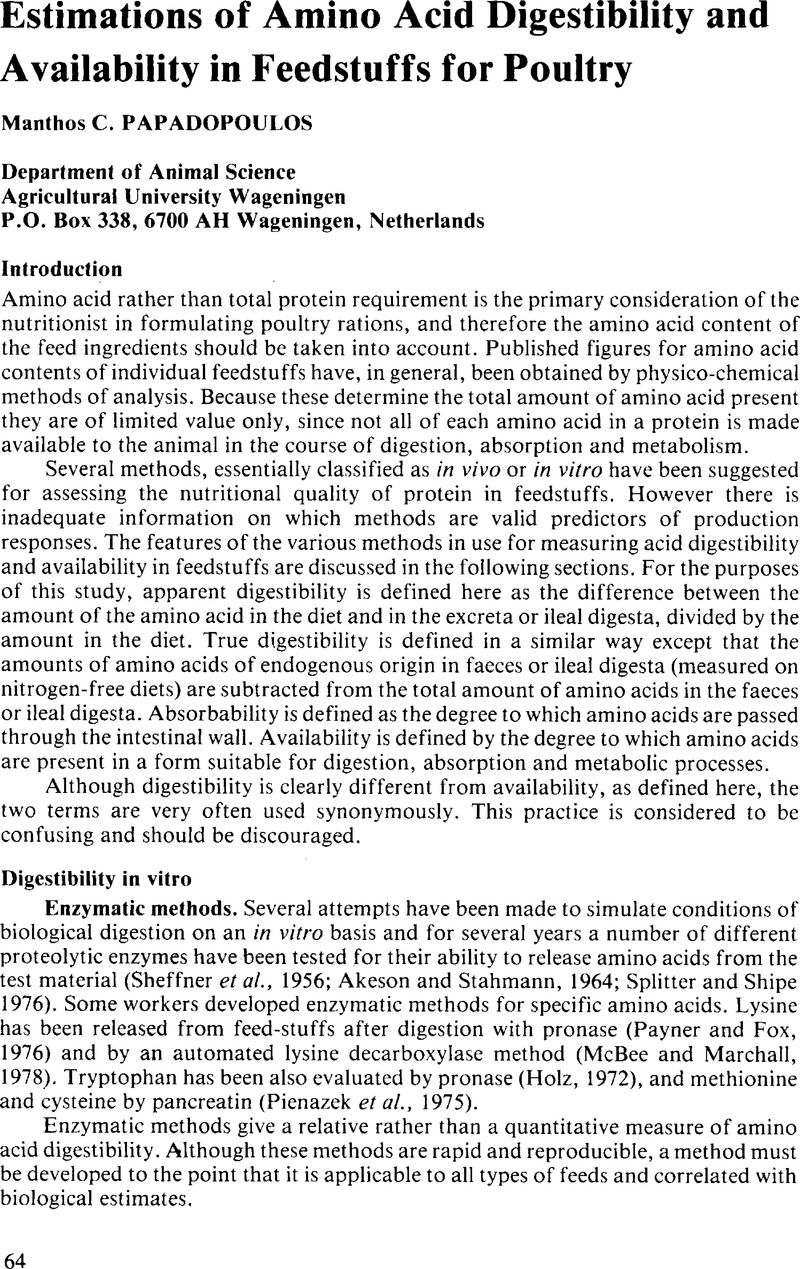Crossref Citations
This article has been cited by the following publications. This list is generated based on data provided by Crossref.
PAPADOPOULOS, M.C.
EL BOUSHY, A.R.
and
KETELAARS, E.H.
1985.
Effect of Different Processing Conditions on Amino Acid Digestibility of Feather Meal Determined by Chicken Assay.
Poultry Science,
Vol. 64,
Issue. 9,
p.
1729.
Johns, D. C.
Low, C. K.
Sedcole, J. R.
Gurnsey, M. P.
and
James, K. A. C.
1987.
Comparison of severalin vivodigestibility procedures to determine lysine digestibility in poultry diets containing heat treated meat and bone meals.
British Poultry Science,
Vol. 28,
Issue. 3,
p.
397.
Papadopoulos, Manthos C.
1989.
Effect of processing on high-protein feedstuffs: A review.
Biological Wastes,
Vol. 29,
Issue. 2,
p.
123.
CARRÉ, B.
1990.
Feedstuff Evaluation.
p.
283.
Swaisgood, Harold E.
and
Catignani, George L.
1991.
Vol. 35,
Issue. ,
p.
185.
Lewis, Austin J.
and
Bayley, Henry S.
1995.
Bioavailability of Nutrients for Animals.
p.
35.
Kadim, I. T.
and
Moughan, P. J.
1997.
Development of an Heal amino acid digestibility assay for the growing chicken—effects of time after feeding and site of sampling.
British Poultry Science,
Vol. 38,
Issue. 1,
p.
89.
Scott, T.A.
Silversides, F.G.
Classen, H.L.
Swift, M.L.
and
Bedford, M.R.
1998.
Comparison of sample source (excreta or ileal digesta) and age of broiler chick on measurement of apparent digestible energy of wheat and barley.
Poultry Science,
Vol. 77,
Issue. 3,
p.
456.
RAVINDRAN, V.
HEW, L.I.
RAVINDRAN, G.
and
BRYDEN, W.L.
1999.
A comparison of ileal digesta and excreta analysis for the determination of amino acid digestibility in food ingredients for poultry.
British Poultry Science,
Vol. 40,
Issue. 2,
p.
266.
Kadim, I.T.
Moughan, P.J.
and
Ravindran, V.
2002.
Ileal amino acid digestibility assay for the growing meat chicken--comparison of ileal and excreta amino acid digestibility in the chicken.
British Poultry Science,
Vol. 43,
Issue. 4,
p.
588.
., Akbar Yaghobfar
2005.
The Relationship Between Apparent and True Amino Acids Availability in Maize by Comparison of Precision-fed and Conventional Addition Methods.
Pakistan Journal of Biological Sciences,
Vol. 8,
Issue. 7,
p.
1030.
He, Rongyu
Qin, Zheng
and
Qin, Xi
2008.
A Secured Mobile Access Scheme for SMS Message.
Information Technology Journal,
Vol. 7,
Issue. 2,
p.
261.
Moughan, Paul J.
Ravindran, V.
and
Sorbara, J.O.B.
2014.
Dietary protein and amino acids—Consideration of the undigestible fraction.
Poultry Science,
Vol. 93,
Issue. 9,
p.
2400.
Zhuravlev, Mikhail
Vertiprahov, Vladimir
Buryakov, Nicolay
and
Yapontsev, Alexey
2022.
Fundamental and Applied Scientific Research in the Development of Agriculture in the Far East (AFE-2021).
Vol. 354,
Issue. ,
p.
1031.





